
Travel Guide
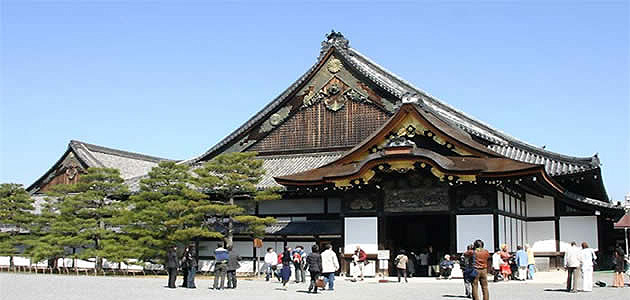
Introduction
Nijojo Castle was built in 1601 as the official Kyoto residence of Tokugawa shoguns. Nijojo Castle is a flatland castle. The castle is a major tourist draw in Kyoto and one of the best preserved castles in Japan. The wide moat, massive stone walls, and heavy yet elaborate gates are still impressive, and were the only fortifications the inhabitants felt necessary, so firm was their grip on power. The grounds are large and contain several lovely gardens as well as groves of plum and cherry trees. The palace building itself is imposing, yet upon closer examination, is rich in decorative detail.
It is one of the seventeen assets of Historic Monuments of Ancient Kyoto which have been designated by UNESCO as a World Heritage Site.
Compounds
Nijojo Castle can be divided into three areas: the Honmaru (main circle of defense), the Ninomaru (secondary circle of defense) and some gardens that encircle the Honmaru and Ninomaru. The entire castle grounds and the Honmaru are surrounded by stone walls and moats. The surface area of the castle is 275,000 square meters, of which 8000 square meters is occupied by buildings.
The castle is an excellent example of social control manifested in architectural space. Low-ranking visitors were received in the outer regions of the Ninomaru, whereas high-ranking visitors were shown the more subtle inner chambers. Rather than attempt to conceal the entrances to the rooms for bodyguards (as was done in many castles), the Tokugawas chose to display them prominently. Thus, the construction lent itself to expressing intimidation and power to Edo-period visitors.
The building houses several different reception chambers, offices and the living quarters of the shogun, where only female attendants were allowed. One of the most striking features of the Ninomaru Palace are the Uguisubari (nightingale floors) in the corridors. To protect the occupants from sneak attacks and assassins, the builders constructed the floors of the corridors in such a way as to squeak like birds when anyone walks on them. Some of the rooms in the castle also contained special doors where the shogun's bodyguard could sneak out to protect him.
The Honmaru and Ninomaru are surrounded by green space and tree lined walking paths. Cherry trees of numerous varieties are planted throughout the castle grounds, including nearly 400 cherry trees of late blooming varieties in a cherry orchard. Because of the many cherry tree varieties present, the blooming season at Nijojo Castle usually lasts from late March through the entire month of April.
The castle also features a plum orchard, which is typically in bloom from late February to early March, and Seiryu-en, a half Japanese, half Western style garden built in 1965 for cultural events such as tea ceremonies. Many areas of the castle grounds are also populated by maple, ginkgo and other trees that offer brilliant autumn colors usually during the second half of November.
Art work
The main attraction of both the Ninomaru and Honmaru Palaces are the opulent decorations within. These were designed to showcase the wealth of the Tokugawa. Elaborate carvings overhanging doorways, themed painted ceiling panels, and beautiful fusuma and cedar door paintings certainly accomplish that end. The Ninomaru Palace features paintings done by Kano School painters. While the original paintings from 1601 were removed in 1626 (with no records of subject or artist), the present works of art date from that year. They feature heavy use of gilt and bright colors. The Tozamurai features a series of three chambers filled with paintings of tigers in a bamboo forest (done by Domi and Shinsetsu). You’ll see these routinely reproduced on Japanese movie and TV sets when they want to show the lodgings of a wealthy samurai, and were also replicated for the American mini-series Shogun. The Shikidai and Ohiroma are filled with works of massive pine trees and willows (by Uneme) filled with birds such as hawks, herons, and ducks. The Kuro-shoin has the better cedar door paintings (by Shume) along with flowers and blossoms. The shogunal living quarters in the Shiro-shoin features landscapes, lakes, and mountains (by Koi).
Unfortunately, paintings done by Kano Tan'yu, Naonobu, Koi, and Sanraku were lost when the Imperial Quarters were moved from the Honmaru to the retired Emperor’s palace in 1629 (neither the building or the paintings survived). All of the paintings done by this group were also lost when most of the structures of the Honmaru burned in 1788.
The paintings in the present Honmaru palace, Prince Katsura’s, were done around 1847 and feature many famous Edo period artists. These include works by Kano Eigaku, Nakajima Raisho, Nakajima Kayo, Nagano Sukechika, Yagi Kiho, Maruyama Oryu, Tamura Kyoshu, Kishi Chikudo, Hara Zaisho, Nagasawa Roshu, and others including the noted Reizei Tamechika. These generally feature landscapes and birds.
History
In 1601, Tokugawa Ieyasu, the founder of the Tokugawa Shogunate, ordered all the feudal lords in Western Japan to contribute to the construction of Nijojo Castle, which was completed during the reign of Tokugawa Iemitsu in 1626. Parts of Fushimi-jo Castle, such as the main tower and the karamon, were moved here in 1625-26. It was built as the Kyoto residence of the Tokugawa Shoguns. It was also constructed as a demonstration of the shogun’s power and prestige and to signal the demise of the emperor. It was designed to resemble the Kyoto Imperial Palace. The Tokugawa Shogunate used Edo as the capital city, but Kyoto continued to be the home of the Imperial Court. Kyoto Imperial Palace is located north-east of Nijo-jo Castle.
In 1611, Ieyasu was able to arrange a meeting at Nijojo Castle with Toyotomi Hideyori. Here Ieyasu discovered that Hideyori was not the fool that he had been led to believe, and likely finalized his decision to completely destroy the Toyotomi. The castle served as the Tokugawa headquarters for the Osaka Campaign of 1614-1615, during which Ieyasu succeeded in eradicating the Toyotomi line. A large victory celebration was held at the castle at the end of hostilities.
Tenshu (the central keep) was struck by lightning and burned to the ground in 1750.
In 1788, the Inner was destroyed by a city-wide fire. The site remained empty until it was replaced by a prince's residence transferred from the Kyoto Imperial Palace in 1893.
In 1867, the Ninomaru Palace was the stage for the declaration by Tokugawa Yoshinobu, returning the authority to the Imperial Court. Next year the Imperial Cabinet was installed in the castle. The palace became imperial property and was declared a detached palace. During this time, the Tokugawa hollyhock crest was removed wherever possible and replaced with the imperial chrysanthemum.
In 1939, the palace was donated to the Kyoto City and opened to the public the following year.
In the 21st century, typhoons have periodically caused sections of plaster to peel off the walls after exposure to rain and wind.
What to see
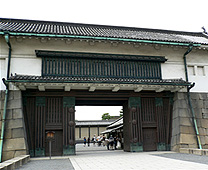 |
Higashi Otemon Higashi Otemon is the main gate of Nijojo Castle. Adjacent to it is the parking space. It is designated as Important Cultural Heritage. |
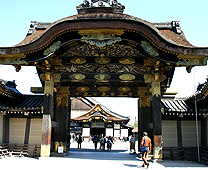 |
Karamon The Karamon (Chinese arched gable gate) is the main entrance to the Ninomaru Palace. It was transferred to Nijo from Fushimi Castle by the third Shogun in 1626. Kamon is highly ornamented gold leaf fixtures and carvings on the Karamon Gate. Decorations include butterflies, cranes, a dragon, and the Imperial Chrysanthemum crest. Visitors can see Tokugawa Sougunate’s intention of overriding the Emperor from the luxury decoration. |
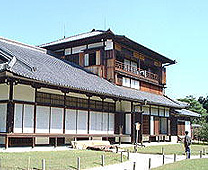 |
Honmaru Goten (Honmaru Palace) The current structure was known as Katsura Palace before being relocated to the present site in 1893 when it was renamed. Originally the palace had 55 buildings, but only a small part was relocated. In 1928 the enthronement banquet of the Showa Emperor (Emperor Hirohito) was held here. Honmaru Palace has a surface area of 1600 square meters. The complex has four parts: living quarters, reception and entertainment rooms, entrance halls and kitchen area. The different areas are connected by corridors and courtyards. The architectural style is late Edo period. The palace displays paintings by several famous masters, such as Kano Eigaku. The inside of these buildings can not be visited, one can only wander around the garden. The inside is only open to public during the special open days in spring and fall. |
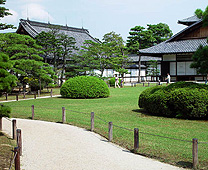 |
Honmaru Garden The original garden was lost to fire in 1788 but rebuilt in the dry-landscape style garden in 1894. The current garden was reformed by the order of Meiji Emperor on 23rd of May, 1895, when he visited Honmaru, and was completed in the ‘hill and grass style’ after seven and a half months of major alteration in 1896. It was thought that, by the middle of the Meiji period, because of the large number of gardens being made in the Western style so the Honmaru garden also received the influence. A ‘Tsukimidai’ (a place to view the moon) is located in the southeast corner of the garden, laid over with grass, arranged with a curved garden path, along the sanukite stone steps trees such as Japanese blue oak and Photinia glabra are planted, and here and there lanterns and garden stones lay. |
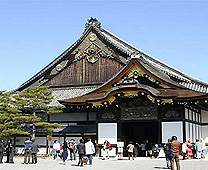 |
Ninomaru Palace Ninomaru Palace served as the residence and office of the shogun during his visits to Kyoto. It is one of Japan’s national treasures, and is made up of 6 bridges, and 33 rooms. The 3300 square meter Ninomaru Palace consists of five connected separate buildings with various chambers and is built almost entirely of Hinoki cypress. Only those of the highest rank were permitted to enter the inner buildings. The decoration includes lavish quantities of gold leaf and elaborate wood carvings, intended to impress visitors with the power and wealth of the shoguns. The palace rooms are covered in tatami mats and have elegantly decorated ceilings. The walls and sliding doors are decorated with paintings by artists from the Kano school. A feature is the fourth chamber (Ohiroma Yon-no-ma) which has some spectacular screen paintings. Buildings that are connected with each other by corridors with so called nightingale floors. Ohiroma iti-no-ma is the largest and grandest room and was the most formal room in the castle. This room bears special significance, because the final Tokugawa shogun returned political power to the Emperor here, effectively marking the end of the samurai period. Outside of the Ninomaru Palace extends the Ninomaru Garden, a traditional Japanese landscape garden with a large pond, ornamental stones and manicured pine trees. |
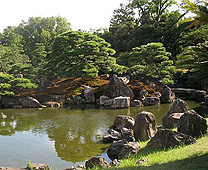 |
Ninomaru Garden The Ninomaru Garden has been designated as a place of scenic beauty by the Japanese Cultural Affairs Agency, and was designed so as to be seen in all its splendor by the Shogun as he held court in Ohiroma. The Ninomaru garden was designed by the landscape architect and tea master Kobori Enshu. It is a beautiful traditional Japanese style garden, which includes a large beautiful pond surrounded by pine trees and a variety of seasonal trees, so every season provides a different vista of color. Despite the obvious beauty of the natural foliage, there is another way to enjoy Japanese gardens, and that is through stone. |
Travel Advice
Sightseeing
- Please refrain from taking pictures in the castle, as flash photography may damage the delicate materials used in the treasures found here. Please respect our heritage so that it may be passed on to the future generations.
- It is prohibited to use a tripod or similar equipment for taking photograph in the precincts.
- Please take care not to kick around or walk on the stones in the garden, in order to preserve the plant life and the integrity of the garden.
- English, Chinese, Korean and Japanese audio guides are available for rent at a kiosk just inside the gate of Higashiotemon.
- Usually there is only one Kamon (crest) in a castle but there are two Kamons in Nijojo Castle. One is hollyhock crest which belongs to Tokugawa family and another is sunflower crest which belongs to the Imperial Family. Nijojo Castle originally was built by Tokugawa family but after Meiji Government took over the castle, the crest of Tokugawa which is higher than the Emperor’s must be removed or to put the crest of Emperor higher than Tokugawa’s. However there is only one exception which can see at Ninomaru Palace. It is the only place that hollyhock crest is higher than sunflower crest because hollyhock crest is too high to be removed or replaced.
- Wheelchairs are available for free.
Nightingale Floor
The Nightingale floor was laid in Nijojo Castle for added security. To guard against intrusion into the Castle by suspicious and dangerous persons like ninja, the floor was designed to sing like a nightingale. The sound is different from that heard in older houses, because of the different way the floor was laid. By suspending the floor above the frame using special iron clamps, the floor can move up and down over the fixing nails when walked upon. This causes the nails to rub against the wood and create a sound similar to the cheeping of a nightingale. All the floors in the castle, from the entrance to Ohiroma, are this type of floor. When you visit Nijojo Castle, try your best to walk along the floor without making a sound ── if you can, perhaps you are secretly a ninja!!
Ninomaru
Ninomaru (Second Palace) means “outer defense”, and the heads of the castle like the shogun, or Japanese feudal lord, lived here, so they could be best prepared for emergency in battle.
Kano school
The Kano school was the largest Han painting school and was in existence from the late Muromachi period to the beginning of the Meiji period in about 1900. The Kano school members were blood relations, so this group of painters was a family and school combined.
The Kano school served the shogunate for 200 years, and received hospitality and respect from all persons who settled in Japan. In the Muromachi period, an ancestor of Masanobu was awarded the status of official painter by the Shogun, and he thereafter founded the Kano style. Following Masanobu, Motonobu (1476-1559) became the head of the Kano school, and he created a technique whereby the golden decorations of the Yamato painting style were introduced into Han paintings. This is interesting, because the far clearer the Yamato style is almost completely the opposite of the Han type.
“The History of Honcho paintings” written by Kano in 1691, says Tanyu created a new Kano style. He made great use of space and decoration in his pictures, and experimented broadly with tones he drew from Chinese ink brush technique. His drawings are plainer than other Kano school members, but he decorated the walls of Nijojo Castle as a prominent member of the Kano school when he was just 25 years old (in 1626).
Events
| Events in 2019 | ||
| Nijojo Castle Illunimation | Evening light up features hundreds of simultaneously blooming cherry blossoms strewn about its grounds. Many of the visitors are decked out in traditional yukata robes and geta shoes. 6pm - 9pm. | Mar 21(Thu) to Apr 12(Mon) |
Facilities
- Voice guide is provided. Languiges are Japanese, English, Chinese, Korean, French, Spanish and German.
- Free rental for wheelchairs are provided.
- Wedding service is provided. Please ask staff for details.
Visit
| Address | 541 Nijo-jo-cho, Horikawa-nishi-iru, Nijo-dori, Nakagyo-ku, Kyoto-shi, Kyoto | |
| Phone | 075-841-0096 | |
| Admission | Adult: 620 yen (Groups 520 yen) Student: 350 yen Child: 200 yen |
Adult: over 18 Student: 12 to 17 Child: 6 to 11 Groups: over 30 |
| Hours | 08:45 to 17:00 08:00 to 18:00 Jul to Aug 08:00 to 17:00 Sep |
Entry until 1 hour before closing |
| Closed | December 29 to 31 | |
| Duration | 1 hour | |
| Getting There | By Train Take City Bus No.9, 50 or 101 from JR Kyoto Station to the Nijojo-mae bus stop, then walk approximately 1 minute. Take City Bus No.12 or 101 from Karasuma Station on Hankyu Railway Kyoto Honsen to the Nijojo-mae bus stop, then walk approximately 1 minute. 5 minutes ride by car from Omiya Station on Hankyu Railway Kyoto Honsen. 1 minute walk from Nijojo-mae Station on subway Tozai Line. By Car Take Meishin Expressway to the Kyoto-higashi exit. It is approximately 25 minutes from exit. Take Meishin Expressway to the Kyoto-minami exit. It is approximately 30 minutes from exit. |
|
| Parking | Paid parking available | |

